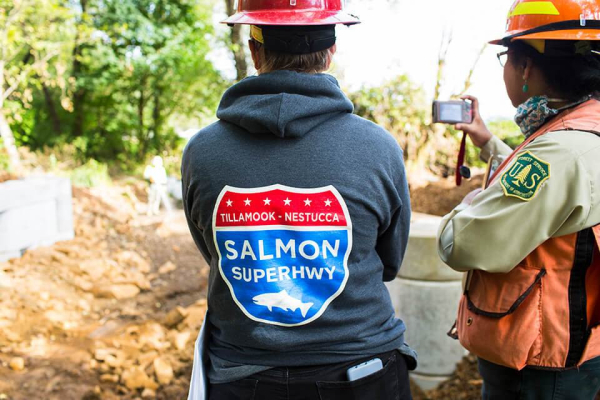
|
Oregon’s Tillamook and Nestucca watersheds were historically some of the most productive waters for salmon, steelhead, and trout in the Pacific Northwest. Over the past century, however, much of the habitat here became fragmented due to road construction and flood control development, although otherwise much of these stream systems remain pristine.
Trout Unlimited is a founding partner in the groundbreaking program created to reconnect this productive fish habitat, at an almost unprecedented scale: the Salmon Superhwy.
The audacious goal of the Salmon Superhwy is to enable trout, salmon and steelhead to again migrate freely throughout 940 square miles of their historic habitat, while at the same time improving road conditions, transportation safety, and flood control.
The Salmon Superhwy program connects farmers and fishermen, loggers and conservationists, communities and fish, uniting them behind a collaborative effort to help struggling fish populations in a region whose cultural history is closely tied to the fish. Failing road culverts and stream crossings not only block fish passage, but also wash out roads and farms.
When complete, the Salmon Superhwy will benefit 178 river miles in the Nestucca, Tillamook, Trask, Wilson, Kilchis and Miami rivers. For anglers, this means more fishing opportunities in more areas.
Chrysten Lambert, Oregon Director for Trout Unlimited, says, “The Salmon Superhwy is already one of the most unique and successful fish restoration efforts in North America. As with so much of our work, partnerships are key, and some of our most important partners in this program are businesses based in this region or with a stake in its outcomes. Folks like Loon Outdoors are absolutely vital to our success.”
The Salmon Superhighway doesn’t just throw resources at this challenge randomly. On the contrary, this program is characterized by its strategic analysis, planning and scaling up of work to remove or mitigate fish passage barriers in a region with legendary salmon and steelhead runs—and fishing heritage.
It started taking shape in 2006, when fisheries scientists and local habitat experts began assessing the entire Nestucca-Tillamook river landscape for salmon and steelhead recovery potential (it’s very high). Through a detailed cost-benefit analysis, these early partners determined a portfolio of actions that achieves maximum habitat bang-for-the buck: 93 projects that improve access for six species of ocean-going fish to 95% of the habitat available that can be done in 10 years at a cost of only $34 million.
TU’s Salmon Superhighway Coordinator, Sarah Zwissler, plays a key role in this innovative program. She’s doing some darn good work. In the first 5 years of the program, 29 of the 93 priority barriers have been removed and over 80 miles of habitat has been reconnected (nearly half of the 180 mile goal), while the program has leveraged $8.6 million in total funding and created 129 jobs.
Success begets more success. NOAA Fisheries recently committed $1.2M to support the program over the next 3 years, along with a mix of other federal, state, and private partners.
Smart planning and budgeting, sound science, and a dedicated group of people committed to a cooperative effort to achieve meaningful conservation goals—that’s the Salmon Superhwy program in a nutshell, and a hallmark of TU’s habitat restoration work more broadly.
Visit http://www.salmonsuperhwy.org/ to learn more.